Cutter’s Way
[DVD]
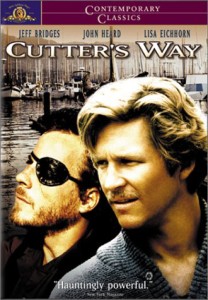
view/request
“These are just the facts, Rich. I mean, I haven’t even begun to let my imagination loose on this thing.”
A film about our first head librarian? Telling a tale of the creation of the Cutter System (the same system Forbes Library uses to this day)? I’m afraid not… though Dylan and I are working on the second draft of the Charles Ammi Cutter Story. In theaters 2039.
Rather, Cutter’s Way is a film directed by Czech New Wave pioneer Ivan Passer that stars Jeff Bridges and John Heard. Heard plays Alex Cutter, a one armed, one legged, eye patch wearing bitter Vietnam veteran who is on the verge of losing touch with reality. Side bar: I tend to get drawn to movies where a character wears an eye patch (True Grit, The American Friend (though Nicholas Ray really needed to wear one of those in real life), Kill Bill, Thunderball or any pirate film come to mind). Cutter lives his life with the feeling that he has nothing to lose and often exists in a drunken stupor without the will to live. Though his antics on some occasions are entertaining to his wife Mo and his closest friend Richard Bone (Jeff Bridges), most of the time he’s putting himself and others in danger.
Bone, a yacht salesman who doubles as some sort of refined-hippie-vagabond-couch-surfing dude, witnesses the disposing of a body after a murder. He decides to flee the scene and not get involved (not getting involved happens to be a central theme of Richard Bone), but winds up being questioned and finds himself on the front page of the paper. Cutter, in turn, becomes obsessed with this case and is convinced he knows who has committed the terrible act.
Cutter’s Way is an overlooked film that explores the limits of friendship and expertly combines the genres of drama, mystery, comedy, adventure and film noir.
Reviewed by Jason
Tagged: Drama, Fiction, Mystery
Under the Volcano
by John Huston
[DVD]

view/request
Albert Finney stars in one the last films by the prolific American director, John Huston. Under the Volcano is based on the semi-autobiographical novel by Malcolm Lowry.
Delusions and alcoholism are the central themes of this film. We join Finney’s character, Geoffrey Firmin, just after the Day of Dead fiesta in Mexico in 1939. Firmin, who is an alcoholic and bitter English consul, wanders throughout a beautiful Mexican village with his life spiraling out of control. Though he tries to pull himself together when his estranged wife (played by Jacqueline Bisset) stops for a visit, moments of clarity and decent behavior are few and far between.
Finney’s portrayal of this troubled character would most likely be over the top handled by another actor. He manages to create someone loud and belligerent, pitiful and charming on some occasions. We want him to dig himself out of this self-inflicted crisis, but we understand that he’s incapable. Huston paints this personal drama with the beauty of the Mexican village and also a strange wallpaper of supporting characters (including the director/writer/actor Emilio Fernández).
This Criterion Collection dvd has a painstakingly assembled bonus disc that profiles John Huston, provides behind the scenes footage and includes the film Volcano: An Inquiry into the Life and Death of Malcolm Lowry (narrated by the late Richard Burton).
Reviewed by Jason
Tagged: Alcoholism, Drama
Welcome to the Monkey House
[DVD]
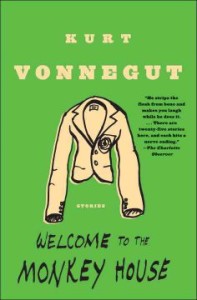
view/request
Selections from Kurt Vonnegut Jr.’s Welcome to the Monkey House, an anthology of shorter fiction, appeared on the Showtime channel in the early 1990’s. The series was on the air for a brief time, but all of the episodes exist on a dvd that we’ve just received from the Pleasant St. Video collection.
Welcome to the Monkey House is fascinating from the outset; the author makes an on camera introduction to the episodes. His opening dialog is the only instance of seeing him on film/tape that I can recall (until this moment, I’ve used my imagination to estimate his mannerisms via book jacket photographs!).
The stories and the overall feel of the series strike a kinship with David Lynch and Mark Frost’s Twin Peaks. Both idiosyncratic television programs were on the air around the same time, draw from 1950’s style and also deal with the abnormal. A mysterious double life, a sadistic battle of wits involving humans as chess pieces, a woman’s obsession with home design catalogs and a child’s eventful night without a babysitter all feature in Welcome to the Monkey House.
Vonnegut has always struck me as someone who has the ability of skillfully introducing science fiction elements or ideas into his writing without having them seem far removed from contemporary society. Though he often delves into the world of science fiction, I can’t classify him solely as a science fiction writer. His laconic central characters tend to ease us into strange, new worlds by having a dark sense of humor or an overall surly, sarcastic attitude toward the present state. For instance, a soap opera actor portraying a doctor is lead into mansion that houses an elderly woman whose only original body part is her head. The actor is initially surprised, but accepts the situation within moments after the orchestrator of this scientific achievement gives his explanation in the most blasé fashion possible.
Kurt Vonnegut’s stories are wonderfully captured in this series and feature performances by Madeline Kahn, Frank Langella, Jon Cryer and many more fine character actors. It was a short lived television program, but it managed to capture some of the author’s bizarrely brilliant concepts.
Reviewed by Jason
Tagged: Drama, Fiction, Humor, Science fiction
Camping with Henry and Tom
by Mark St. Germain
[Audiobook]
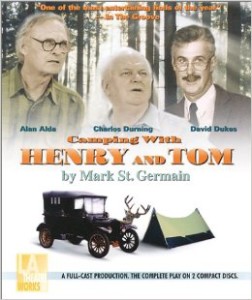
view/request
This “book” is the audio to a play performed at L.A. Theatre Works in 2006 starring Alan Alda and was borrowed using Overdrive (see the reference desk for more information on how to download free books to your phone or e-reader!).
The off-broadway play is a fictional account of inspired by an actual camping trip in 1921 with friends Henry Ford, Thomas Edison and Warren Harding. The three men set off camping and their car breaks down and we hear their chatter as they are lost in the woods. It is filled with humor and historical facts as we hear how Ford aspires to be President and President Harding would rather spend time with a mistress.
Reviewed by Janet
Tagged: 1920s, Drama, Fiction, Play
The story of Vernon and Irene Castle
[DVD]
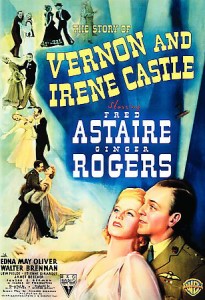
view/request
Based upon the true story of the celebrated husband and wife dancing team who popularized ballroom dance, this film is the most realistic, the most tragic, and the most touching of the Astaire-Rogers films. The film takes place in the years between 1911 and 1918, and the costumes and music are largely appropriate to that era. Most of the dance sequences emulate the Castle’s distinctive style—Astaire tap dances in only one number and Rogers not at all—and the musical numbers are fewer and more tightly integrated into the plot than in other Astaire films. Of course, the film still delivers what you expect from an Astaire-Rogers collaboration: Astaire is charming, the music is great, the dancing better, and the two stars may have better on-screen chemistry in this film than in any other.
Reviewed by Ben
Tagged: Comedy, Dance, Drama, Feature film
The Red Shoes
[DVD]
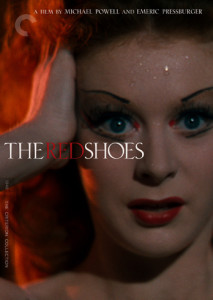
view/request
The Red Shoes is a visually stunning dramatic work about a ballet company led by the ruthless and contentious, but often charming director Boris Lermontov. Lermontov discovers dancer Vicky Page (portrayed by famed English ballet star Moira Shearer) at a society party and realizes her unparalleled potential. Before signing her to his company she must decide what role dancing plays in her life. Is it a passion she pursues or shall it consume her entirely? Can an artist love anything or anyone more than their craft? These conflicts becomes the underlying theme of the picture.
The Hans Christian Andersen story of The Red Shoes is the source in which the main ballet within the film is based. Instead of just viewing the performance from the theater audience’s perspective, Powell and Pressburger take the camera’s inside the action for a breathtaking, 17-minute sequence. We follow Page closely via dolly shots through various enormous, painted set pieces, close-ups of dancers movements and expressions and rich colored lights. The co-directors also chose to allow fantasy to be a part of the stage presentation as well with tasteful in camera visual effects.
The Red Shoes, which melodrama and beauty reach unbelievable heights, is a remarkable achievement in cinema.
Reviewed by Jason
Tagged: Ballet, Drama, Feature film
Alfie
[DVD]
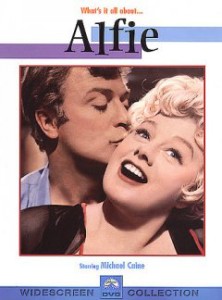
view/request
Lewis Gilbert’s 1966 masterpiece drama/comedy stars Michael Caine in the title role. Alfie is a street smart character who is here only to enjoy life and often has little consideration for others. He moves quickly from partner to partner (sometimes in seedy arrangements), but is eventually forced to come to terms with his reckless behavior, lack of income and aging body. Alfie sports an interesting storytelling model: either to have a quick laugh or explain how he’s feeling at any given time, Caine often breaks the fourth wall to converse with the viewer.
With supporting characters played by Shelly Winters, Jane Asher and Denholm Elliott, clever comedic dialog, twists and turns to the tragic and a swinging jazz score by Sonny Rollins, Alfie remains one of the richest films to ever grace the screen.
Reviewed by Jason
Tagged: Comedy, Drama, Feature film, Fiction, Manhood
Arranged
[DVD]

view/request
Two young women, an Orthodox Jewish and a Muslim, meet as first year teachers a public school in Brooklyn. They become friends as they share their troubles in finding suitable matches for arranged marriages. Arranged is a satisfying, warm, and at times, amusing independent film.
Reviewed by Jennifer
Tagged: Brooklyn, Drama, Feature film
Summer Hours
[DVD]
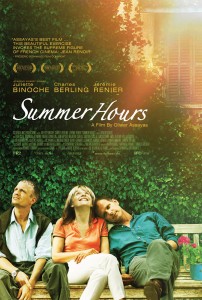
view/request
Three siblings’ memories of the past and aspirations for the future collide when confronted with their shared inheritance of an exceptional 19th century art collection and the family’s country house in Oliver Assayas’ 2008 feature film. Left to negotiate the future of the collection and the country house in which it has been kept, Adrienne (Juliette Binoche), a successful New York designer, Frédéric (Charles Berling), an economist and university professor in Paris, and Jérémie (Jérémie Renier), a dynamic businessman in China, confront the end of childhood, their shared memories and backgrounds, and unique visions of the future. The film is a complex spin on the traditional pastoral country house film and poses questions about the power of objects and their connection to the sentimental allure of the past in an age of globalization. One of two feature films that developed out of a proposed series of shorts that would have been produced to celebrate the Musée D’Orsay’s twentieth anniversary (the other film, The Flight of the Red Balloon, also starred Binoche). Despite these heady themes and what sounds like a relatively mundane plot, the film remains focused and often riveting due to its great casting and exceptional cinematography. French Language, with subtitles.
Reviewed by Dylan
Tagged: Drama, Feature film, Foreign film, French language
A Prophet
[DVD]
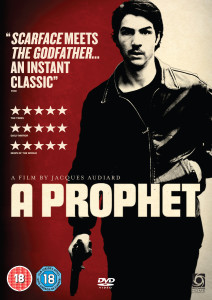
view/request
A brutal, raw and riveting look at the progression and growth of a young convict in the harsh environment of a French prison. Nineteen year-old Franco-Arab Malik El Djebena is just beginning his six year prison sentence in Brécourt after a youth spent primarily in detention centers. As a new inmate without friends or enemies inside, he finds the prison divided between Corsicans and Muslims, with the Corsicans holding the balance of power because of influence with the prison guards. Tahar Rahim is excellent as El Djebena, and seems to transform physically as his character rises from isolation and illiteracy to become a key player within Brécourt and beyond its walls. Director Jacques Audiard builds tension masterfully throughout, drawing out scenes with excruciating anticipation before moments of shocking violence. Frequently compared with the Godfather, this French Language film received the 2009 London Film critics “Best Feature Film” Award and was nominated for a 2009 Oscar for Best Foreign language Film.
Reviewed by Dylan
Tagged: Drama, Feature film, Foreign film, French language










